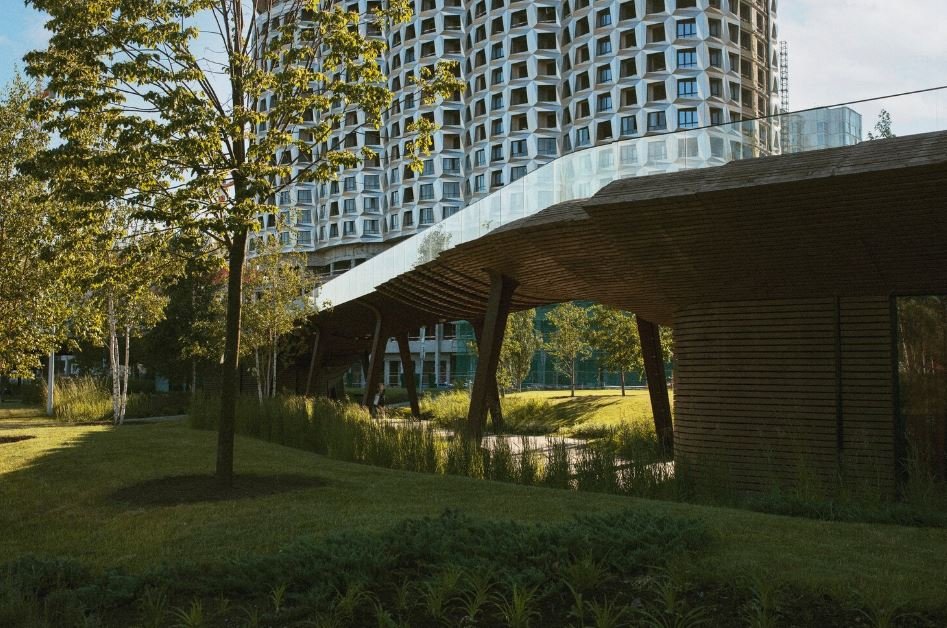
Architects are creating buildings that grow, breathe, and react like living things in crowded city hallways where steel and glass were once considered inert symbols of progress. These structures are remarkably alive in addition to being efficient. They use the instincts of natural organisms to heal themselves, consume pollutants, and adjust to changing climates.
Engineers are using materials that actively interact with their environment in their construction projects, such as mycelium, bacteria-infused concrete, and algae. Innovative systems, such as window panels filled with algae, carry out photosynthesis every day, lowering carbon dioxide levels and generating clean energy. These bio-reactive panels, which provide dynamic shading and oxygenate city air, are a notable improvement over early passive solar technologies.
| Feature | Description |
|---|---|
| Mycelium Bricks | Bio-grown materials that are lightweight, insulating, and compostable. |
| Bacteria-Infused Concrete | Repairs its own cracks through bacterial reactions with water. |
| Algae Panels | Absorb CO₂ and produce oxygen while generating bioenergy. |
| Living Facades | Use moss and microalgae to clean air and regulate temperature. |
| Adaptive Architecture | Materials that respond to environmental changes for improved efficiency. |
| On-Site Energy Systems | Rooftop solar, wind-integrated walls, and cogeneration plants. |
| Water Reuse Systems | Filter and recycle greywater for irrigation and plumbing. |
| Sensor-Driven Biotech | Monitors light, nutrient levels, and performs autonomous maintenance. |
| Living Building Challenge (LBC) | Certification promoting regenerative design beyond sustainability. |
| Urban Integration | Turns cities into ecological systems that support biodiversity. |
These structures embody regenerative living, which goes beyond green design, by embracing natural cycles. To create a vertical forest in the middle of the city, the Breather skyscraper in Oslo, for example, uses microalgae in its façade to convert pollutants into innocuous byproducts. While conventional buildings only reflect the dirt, it continues to purify the air during rush hour.
Cities like Tokyo, Paris, and Rotterdam have started implementing living wall and roof prototypes that are covered in moss, fungi, and microalgae during the last ten years. These facades have many uses; they naturally cool buildings, lower heat islands, and encourage the growth of local biodiversity. They are, in many respects, reintroducing forests into the heart of cities.
The PAE Living Building in Portland was built with complete off-grid survival in mind. Constructed to satisfy the exacting requirements of the Living Building Challenge, it collects rainwater, filters waste locally, and produces more energy than it uses. It challenges the notion that buildings are a burden on the city’s infrastructure by utilizing closed-loop systems and materials strategically.
Bacterial-infused bioengineered bricks can be grown on-site during construction, significantly lowering transportation-related emissions. Under the correct circumstances, these bricks can self-replicate by splitting in half, with each side growing into a new brick. In climate-vulnerable areas, that once-fantastical concept is now being investigated for scalable housing.
Some architects make sure that every part of the building lifecycle is accountable and transparent by incorporating tracking systems that resemble blockchain. These structures, which include self-healing plaster and bamboo flooring, are designed to be incredibly resilient and environmentally rejuvenating.
Public interest has recently been aroused by media coverage of initiatives such as the BioUrban installations in Mexico City and The GreenLoop in Rotterdam. Developed in Germany, the CityTree system offers smart moss walls that are small enough to fit within a city block and can filter the air just as well as hundreds of trees. These installations are already showing themselves to be surprisingly cost-effective and highly efficient.
Researchers from Newcastle University and Northumbria University have established a biotechnology in built environments research hub through international cooperation. Their OME project, which uses mycelium for roofing and trees for walls, aims to rethink how homes can be grown rather than constructed. These initiatives, albeit still in the experimental stage, demonstrate the pressing need to ground architecture in the intelligence of nature.
Regenerative architecture is becoming more popular among sustainability activists and celebrity philanthropists in the context of climate adaptation. Emma Watson has supported regenerative designs in post-disaster relief shelters, and Leonardo DiCaprio has endorsed algae wall technology in sustainable housing projects. Their participation raises awareness of a movement that was previously limited to design labs and specialized magazines.
Since the introduction of Japan’s bio-towers, which are buildings equipped with adaptive sensors and microfungi, urban planners have started to imagine neighborhoods as living things. With responsive materials installed, every building works together with its urban ecosystem. This method reunites cities with the rhythms of their landscapes instead of separating buildings from the natural world.
Living buildings are architectural symphonies that perform rather than merely exist thanks to advances in bio-fabrication and renewable energy. They restore in addition to providing shelter. They inspire rather than merely comply. We are rethinking shelter as organic infrastructure rather than static shelter through deliberate innovation.
These developments will continue to scale in the upcoming years as materials like carbon-injected cement, ferrock, and hempcrete become economically feasible. By incorporating them into public infrastructure, emissions will be greatly decreased, and new standards for climate-positive building will be established. In addition to making homes smarter, we’re also making them kinder by reconsidering how buildings interact with their surroundings.
Once held responsible for ecological stress, urban areas are now being used as regeneration labs. Architecture regains its agency as a contributor, not a consumer, with every structure that purifies the air, recycles water, or repairs its façade. Living buildings are no longer just a pipe dream. Floor by floor, engineered leaf by engineered leaf, it is expanding.
